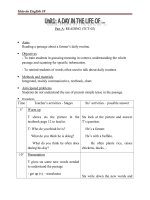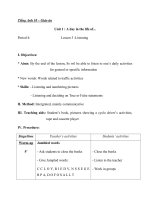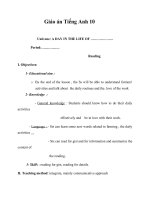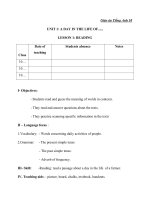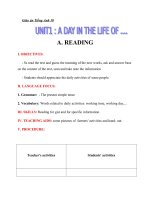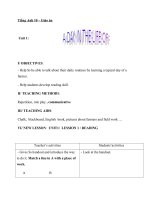Giáo án tiếng anh 10: Unit 1 : A day in the life of... Reading ppsx
Bạn đang xem bản rút gọn của tài liệu. Xem và tải ngay bản đầy đủ của tài liệu tại đây (47.43 KB, 13 trang )
Date:………
Period…….
Unit 1 : A day in the life of
Reading
Time: 45 minutes
I. Objectives:
1. Educational aim: Students should know what a farmer’s day of work is
and sympathize with farmers’ everyday work
2. Knowledge:
- General knowledge: Students know about activities on a day in the life of
farmers
- Language: Sentences and expression for describing someone’s daily
routines
- New words: Words related to a farmer’s daily work
3. Skills: Guessing meaning in context, scanning for specific information
and passage comprehension
II. Method: Integrated, mainly communicative
III. Teaching aids: Student’s book and pictures showing farmers’ daily
routines, etc.
IV. Procedure:
Teacher’s activities Students’ activities Notes
Warm-up: (5 minutes)
- Lead out the hand out and introduce
how to put the name of the job on its
place
1. teacher
2. doctor
3. worker
4. seller
5. farmer
- Ask students some questions
Where does a teacher work?
Where does a worker work?
Where does a farmer work?
- Let students understand more about
the life of a farmer, today we learn
Unit 1- part A: Reading
- Open the book
- Listen to the teacher
- Look at the blackboard
and put two words together
1.b 2.c 3.e 4.a 5.d
- Answer questions:
He works in a school
He works in a factory
He works in the field
- Listen to the teacher and
open the book – Unit 1,
part A: reading
Before you read : (7 minutes)
- Ask students to use the suggestion in
their books to work in pairs
- Ask and answer questions about your
daily routine
- Listen to students and correct
pronunciation and grammar if necessary
- Ask students to look at the picture in
the book
- Show students to know about farmers’
daily routine
While you read : (23 minutes)
- Ask students to look through the
passage and read in silence
- Help students read the passage
- Explain pronunciation and meaning of
new words which appear in the passage
Task 1 : (3 minutes)
- Ask students to choose the option A,
B or C that best suits the meaning of
the italicized words
- Let students work individual or in
groups
- Help students if necessary
Keys:
1C; 2C; 3A; 4A
Task 2: (4 minutes)
- Ask students to answer the following
questions
- Ask students look through the
passages then try to answer the
questions in right way
- Look at the book, listen to
the teacher and work in pairs:
*A: What time do you
often get up?
B: I often get up at six
*C: What do you often do
in the evening?
D: I often do my home
work and watch T.V
- Look at the picture
- Listen to the teacher
- Listen to the teacher then
read the passages
- Ask some new words if
necessary
- Keep the book open
- Listen to the teacher then
do task 1
- Ask the teacher if
necessary
- Work individual or in
group
- Write down in the
notebook
- Listen to the teacher
- Try to answer the
questions
- Practice with a partner
then write them down in
- Let them work in pairs
- Help students if necessary
(the answers in the passage)
Task 3: (6 minutes)
- Ask students to scan the passage and
make brief note about Mr Vy and Mrs
Tuyet’s daily routines
- Walk round the classroom and
correct mistakes
After you read: (8 minutes)
- Ask students to close their books
- Ask them to talk about Mr Vy and
Mrs Tuyet’s daily routines or their
parents’ daily routines
- Listen to students and correct
mistakes
Home work: (2 minutes)
- Ask students to write a passage about
a farmer’s daily routines (80 words)
- Ask students to do Reading exercise
of Unit 1 in workbook and prepare
Part B : Speaking at home
the note books
- Ask the teacher if
necessary
- Listen to the teacher and
make a brief note about Mr
Vy and Mrs Tuyet’s daily
routines
4.30: alarm goes off
5.15: leaves the house
5.30: arrives the field
- Listen to the teacher
- Try to talk about Mr Vy
and Mrs Tuyet’s daily
routines
- The students who are
called to stand up to talk
loudly are intelligent ones
- Listen to the teacher and
write down homework
***
Date:………
Period…….
Unit 1 : A day in the life of
Lesson 2: speaking
Time: 45 minutes
I. Objectives:
1. Educational aim: Students should know how to spend their daily time
2. Knowledge:
- General knowledge: Students learn about daily activities
- Language: asking for and giving information from a timetable
- New words: words related to students’ daily activities
3. Skills: talking about daily activities
II. Method: integrated, mainly communicative
III. Teaching aids: pictures
IV. Procedure:
Teacher’s activities Students’ activities Notes
Warm-up: (5 minutes)
- Ask students to keep book close
- Write on the board names of ten
subjects which are learnt in secondary
school:
1. Civic education
2. Maths
3. Techonology
4. Physics
5. Literature
6. Biology
7. Chemistry
8. Geography
9. Physical education
10. History
- Ask students to repeat
- The winners who repeat most
- Give marks
- Tell students to understand more
about students’ daily activities.
(We learn Unit 1, part- speaking)
Pre-speaking : (12 minutes)
Task 1
- Ask students to ask and answer about
Quan’s weekly timetable using the
information from the timetable
- Let them work in pairs
- Listen to students and correct
mistakes
- Keep books close
- Listen to the teacher
- Look at the board and
try to remember names of
ten subjects
- Try to repeat from
memory
- Look at student’s book
- Listen to the teacher
- Ask and answer about
Quan’s weekly timetable
A: What time does Quan
have physics on
Tuesday?
B: He has physics at 7.15
on Tuesday.
A: What lesson does
While-speaking : (15 minutes)
Task 2
- Ask students to talk about Quan’s
activities, using the pictures in Task 2
- Let them work in groups
- Walk round and help them
- Ask some students to stand up to talk
again loudly
- Listen and correct mistakes
Post-speaking : (10 minutes)
Task 3
- Ask students to close books
- Ask students to tell the classmates
about their daily rountine
- Walk round and help them
- Let them work in groups
- Ask some students to stand up and
tell loudly
- Listen and correct mistakes
Homework: (3 minutes)
- Ask students to write a passage about
their daily routine (50 words)
- Ask students to prepare Part C-
Listening and do homework
Quan have at 8.55 on
Monday?
B: He has maths at 8.55
on Monday.
- Open the books
- Do task 2 in groups
A: Quan gets up at 14.00
B: He does his homework
at 14.15
C: He watches T.V at 16.30
- Close the books
- Listen to the teacher
- Do task 3
- Work in groups
- The students are called
stand up and tell loudly
A: Everyday, I get up at
5.30, I have breakfast at
6.00 and go to school at
6.30
- Listen to the teacher
- Write down the homework
***
Date:………
Period…….
Unit 1 : A day in the life of
Lesson 3: listening
Time: 45 minutes
I. Objectives:
1. Educational aim: Students should know about a working-day of a cyclo
driver and sympthize with him
2. Knowledge:
- General knowledge: Students learn more about traffic, a cyclo driver’s
activities
- New words: Words related to traffic activities
3. Skills: - Listening and numbering pictures
- Listening and deciding on True or False statements
II. Method: Intergrated, mainly communicative
III. Teaching aids: Student’s book, pictures showing a cyclo driver’s
activities, tape and cassette player
IV. Procedure:
Teacher’s activities Students’ activities Notes
Warm-up: (5 minutes)
- Ask students to close the books
- Give Jumpled words:
C C L O Y, R I E D V, N S S E G E R
P A, D O F O S A L L T
- Ask students to arrange those letters
in right orders
- Check some students and mark
- Give some statements:
He has a cyclo
He drives passenger everyday
He usually has meal at a foodstall
- Give question: Who is he?
- If you want to know more details
about daily activities of a cyclo driver,
we will go to Unit 1- part Listening
Pre-listening: (7 minutes)
- Ask students to look at the part:
Before listening
- Let them work in pairs and make
questions
- Walk round, listen and help students
- Close the books
- Listen to the teacher
- Work in groups
Key:cyclo-driver-
passenger-foodstall
- Listen to the teacher and
answer the question:
He is a cyclo driver
- Listen to the teacher and
open textbooks
- Look at the books
- Listen to the teacher
- Work in pairs
A: Have you ever
travelled by cyclo?
B: Yes, I have
A: When was it?
- Read loudly the words:
distric; routine; office; drop; passenger;
ride pedal; purchases parkl foodstall
- Ask students to repeat loudly the words
- Listen and check pronunciation
While-listening: (20 minutes)
Task 1
- Ask students to look at the pictures
about some activities of Mr Lam, a
cyclo driver
- Let them describe the pictures
- Read loudly or turn on the tapescript
three times
- Ask students to number the pictures
- Help them if necessary
Task 2
- Ask students to look through the
sentences in task 2
- Ask students to listen to the
tapescript again and decide whether
the statements are T or F
- Ask students to give reasons for their
answers
Key: 1.F- 2.T- 3.F- 4.F- 5.F- 6.F
After-listening: (10 minutes)
- Ask students to open the books
- Ask them to ask and answer
questions about Mr Lam’s activities,
using the cues below
- Let them work in pairs
- Walk round and help students
- Ask some students to stand up and
B: Last summer
A: Is it interesting to
travel by cyclo?
B: Yes, it is
- Repeat loudly the words
and try to remember them
- Keep book open
- Look at the pictures in
task 1
- Describe the pictures
- Listen to the tapescript
and number the pictures
Key: a.3, b.5, c.4, d.6,
e.1, f.2
- Keep book open and
listen to the teacher
- Read the sentences in
task 2 and try to
understand them
- Listen to the tapescript
again and decide the
statements that are T or F
then explain them
- Open the books
- Ask and answer about
Mr Lam
A: What’s his name?
B: His name is Lam
A: What’s his job?
B: He’s a cyclo driver
- The students who are
retell Mr Lam’s story to the class
- Listen and correct mistakes
Homework: (3 minutes)
- Ask students to write a story about
Mr Lam
- Remember them to prepare Part-
Writing at home
called stand up and retell
Mr Lam’s story to the
class:
Mr Lam is a cyclo driver
in HCM city. He usually
has a busy working day.
He gets up at 5.30. ….
-Listen to the teacher and
write down homework
***
Date:………
Period…….
Unit 1 : A day in the life of
Lesson 4: writing
Time: 45 minutes
I. Objectives:
1. Educational aim: Students should identify the events
2. General knowledge: Students learn how to write a narrative, stages of a
narrative
- Language: The simple past of verbs and the connectors often used in a
narrative
- New words: Words related to problems on a flight or a fire
3. Skills: Writing a narrative
II. Method: Integrated, mainly communicative
III. Teaching aids: Student’s book, notebook, some pictures showing flying
accidents of hotel fires
IV. Procedure:
Teacher’s activities Students’ activities Notes
Warm-up: (5 minutes)
- Ask students to keep book close
- Ask students some following
questions:
- Keep book close
- Listen to the teacher and
answer the questions
1. Have you ever heard a frightening
story?
2. When and where did it happen?
3. How did you feel?
- Check and explain them to the class:
There are a lot of accidents in our
lives, to understand them we learn part
Writing
Pre-writing: (10 minutes)
- Ask student to read the narrative in
task 1
- Explain some new words
- Ask students to look through the
passage again and find all the verbs
that are used in the past simple and the
connectors (time expression)
- Let them work in groups
- Walk around, check and help
students
- Explain to students to use the simple
past to rewrite a story
While-writing: (18 minutes)
Task 2
- Ask students to do task 2
- Let them work in groups
- Go round, check and help students
1. Yes, I have
2. It happened when I
was young
- It happened in my
neighborhood
- It made me frightened
- Listen to the teacher
and open the books
- Read the narrative
- Ask the teacher if
necessary
- Look through the
passage again and find all
the verbs that used in the
past simple and the
connectors
- Work in groups
Key: stared; was; arrived;
got; took off; began;
thought; were told;
seemed; realized; were;
screamed; thought; felt;
announced; was; were;
landed; was; at first; then;
just then; a few minutes
later; one hour later
- Do task 2 in groups
Student A: identify the
events: got on plane;
plane took off; hostesses
were just beginning to
serve lunch when plane
began to shake; plane
seemed to clip; people
screamed in panic
Task 3
- Ask students to keep book open
- Ask them to use the prompts to build
up a narrative about a hotel fire
- Let students work individually
- Walk round and help students
Post-writing: (10 minutes)
- Give suggestions and corrections
- Ask students to read another’s
narrative
- Ask some students to read loudly
their narratives
- Correct mistakes and mark
Homework: (2 minutes)
- Ask students to do part writing of
Unit 1 in the student’s work book and
prepare part Language Focus
Student B: identify the
climax: we thought we
had only minutes to live
Student C: identify the
conclusion of the story:
everything was all right,
we landed safely
- Listen to the teacher
- Use the prompts to build
up a narrative about a hotel
fire (work individually)
- Listen to the teacher
- Finish the narrative
- Read a narrative of one
classmate
- Some students read
loudly their products in
front of the class
- Listen to the teacher and
write down homework
***
Date:………
Period…….
Unit 1: A day in the life of
Lesson 5: language focus
Time: 45 minutes
I. Objectives:
1. Educational aim: Students should describe someone’s daily activities or
write a narrative
2. Knowledge:
- General knowledge: Students learn how to write a passage about
someone’s hobby or a narrative
- Language: * The present simple and adverbs of frequency for talking about
daily activities
* The past simple used in a narrative
- New words: Words related to pronunciation /I/ - /i:/
3. Skills: Writing a passage about someone’s hobby
II. Method: Integrated, mainly communicative
III. Teaching aids: Student’s book, pictures showing some activities
(fishing, reading, going on a boat…)
IV. Procedure:
Teacher’s activities Students’ activities Notes
Warm-up: (5 minutes)
- Ask students to keep book close
- Give the picture that has a sheep on
the ship
- Ask students to complete the
sentence:
I see a … on the….
- Ask students to speak the sentence
loudly
- Let students to get their attention on
pronunciation: /I/- /i:/
- Introduce new lesson
Pronunciation: (8 minutes)
- Ask students to look at their books
then introduce to them
*Listen and repeat:
- Read loudly then ask students to repeat
- Introduce: /I/ - /i:/
- Correct pronunciation for the students
* Practice these sentences
- Keep book close
- Listen to the teacher
- Look at the picture and
complete the sentence:
I see a sheep on a ship
- Open the books
- Look at : Listen and
Repeat
- Repeat the words in
chorus then individual
- Read the sentences loudly
- Ask students to repeat
- Correct pronunciation for students
Grammar and vocabulary:(4 minutes)
- Introduce exercises to the students
- Let students get their attention to
focus on present simple, past simple
and adverbs of frequency
Exercise 1: (8 minutes)
- Ask students to do Exercise 1
- Introduce how to do it
- Let them work in pairs
- Walk round, check and give mark
Exercise 2 (8 minutes)
- Introduce Exercise 2 to students and
explain how to do it
- Ask students to do it
- Let them work individually
- Check, correct mistakes
Exercise 3: (10 minutes)
- Introduce Exercise 3 to students and
explain how to do it
- Ask students to do it
- Let them work individually
- Walk round and help them
- Check, correct mistakes, give reasons
and mark
- Look at Practice the
sentences
- Listen to the teacher
then repeat in chorus then
individual
- Listen to the teacher
- Listen to the teacher and
do exercise 1
Key: 1.is – 2.fish –
3.worry – 4.are – 5.catch
– 6.am – 7.catch - 8.go –
9.give up – 10.says – 11.
realize – 12.am
- Listen to the teacher and
do exercise 2
Eg:
He usually gets up early
She is never late for school
- Listen to the teacher and
do exercise 3
Key: 1.was done-
2.cooked–3.were
4.smelt–5.told- 6.sang–
7.began– 8.felt–9.putout-
10.crept–11.slept–
12.woke–13.was–
14.leapt–15.hurried–
16.found–17.wound–
18.flowed
Homework: (2 minutes)
Ask students to do Part Language
Focus and prepare part Reading of
Unit 2 at home
- Listen to the teacher and
write down
***



